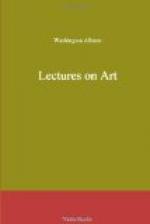We have thus considered the human being in his complex condition, of body and spirit, or physical and moral; showing the impossibility of even thinking of him in the one, to the exclusion of the other. We may, indeed, successively think first of the form, and then of the moral character, as we may think of any one part of either analytically; but we cannot think of the human being except as a whole. It follows, therefore, as a consequence, that no imitation of man can be true which is not addressed to us in this double condition. And here it may be observed, that in Art there is this additional requirement, that there be no discrepancy between the form and the character intended,—or rather, that the form must express the character, or it expresses nothing: a necessity which is far from being general in actual nature. But of this hereafter.
Let us now endeavour to form some general notion of Man in his various aspects, as presented by the myriads which people the earth. But whose imagination is equal to the task,—to the setting in array before it the countless multitudes, each individual in his proper form, his proper character? Were this possible, we should stand amazed at the interminable differences, the hideous variety; and that, too, no less in the moral, than in the physical; nay, so opposite and appalling in the former as hardly to be figured by a chain of animals, taking for the extremes the fierce and filthy hyena and the inoffensive lamb. This is man in the concrete,—to which, according to some, is to be applied the abstract Ideal!
Now let us attempt to conceive of a being that shall represent all the diversities of mind, affections, and dispositions, that fleck this heterogeneous mass of humanity, and then to conceive of a Form that shall be in such perfect affinity with it as to indicate them all. The bare statement of the proposition shows its absurdity. Yet this must be the office of a Standard Form; and this it must do, or it will be a falsehood. Nor should we find it easier with any given number, with twenty, fifty, nay, an hundred (so called) generic forms. We do not hesitate to affirm, that, were it possible, it would be quite as easy with one as with a thousand.
But to this it may be replied, that the Standard Form was never intended to represent the vicious or degraded, but man in his most perfect developement of mind, affections, and body. This is certainly narrowing its office, and, unfortunately, to the representing of but one man; consequently, of no possible use beyond to the Painter or Sculptor of Humanity, since every repetition of this perfect form would be as the reflection of one multiplied by mirrors. But such repetitions, it may be further answered, were never contemplated, that Form being given only as an exemplar of the highest, to serve as a guide in our approach to excellence; as we could not else know to a certainty to what degree of elevation our conceptions might rise. Still, in that case its use would be limited to a single object, that is, to itself, its own perfectness; it would not aid the Artist in the intermediate ascent to it,—unless it contained within itself all the gradations of human character; which no one will pretend.




